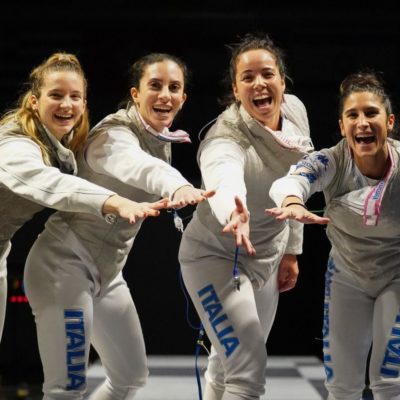{mosimage} In November 2003, the FIE voted to adopt several changes to the rules governing how foil is fenced. The timeline of changes, how they will be enacted, and certain other specifics still need to be made clear. At the very least, the changes have been announced, and this indicates that we fencers (and coaches) are supposed to start considering how our games will change.
This article is a Nostradamus-style prophecy of how these rule changes will change the shape of foil fencing. We try to extrapolate, from a few changes in box-timing and springs, what tactics and technique will be useful to “future-foil.” After the changes, there will be a short window of opportunity where results and rankings will be screwed up — a fencer who has trained to the changes will have a chance to change their standing.
Shorter time for “blocking-time”: 300 milliseconds (was 550)
Longer impact-time: 15 milliseconds (was 2)
More impact-power: 750 grams (was 500)
Change foil maximum curvature to 1cm
Fleche stays in foil
Reversed shoulders no longer an offense in foil
Use of a “mangiarotti” tip
Online member Veeco captures the essence of these changes:
…I think the general idea behind reducing the lockout timings is to have [fewer] two-light actions, thus making the refereeing easier and the actions easier to understand by the fencers.
Basically, the referee will look at the lights, and if there is only one light, that means that the attack or counter-attack in time was valid. If there are 2 lights, then it means that the attack was valid if there was no parry, or that the riposte was valid if the attack was parried.
In sabre, the fact that the lockout time just slightly higher than the human reaction time actually makes a lot of sense. That means that someone who is preparing an attack won’t have the time to finish their attack if they get hit during the preparation. Thus they will have to have already launched the attack when they get hit by the counter attack for their attack to be valid. They cannot “react” to the hit during the preparation, because if they do so, their light won’t go off. And the referee will only see a one light action, as well as the spectators.…
Timeline
Some or all of these changes will take effect after the 2004 Olympics, starting October 2004 or early 2005. They will be propogated initially to junior and cadet tournaments, and the changes will eventually be adopted for adult fencing. At some point, the USFA will also ratify the changes for American fencers. Most of the changes indicate updates to the scoring boxes, though the “Mangiarotti tip” looks like it may entail changes to all electric foils.
Not anti-flick, but rather pro-tip
These changes in foil were not explicitly undertaken to kill the flick — otherwise we would have heard an uproar from many top-level fencers and several fencing federations. The changes were probably promoted as a way of reviving the importance of point-attacks, and all the concomitant point technique like parries, binds, coupés, and even feint disengages which have been languishing recently at the highest levels.
Arcing flicks, marching footwork, and the tactics to defend against them were originally borrowed from sabre. These moves are undoubtedly prospering in foil, but the FIE’s language when justifying the rule changes contains terms like “foil’s specific character” and “foil heritage” — they’re looking for something foily, which is tip and Right of Way.{mospagebreak}
Shape of foil fencing in the future: Overview
For all intents and purposes, it’s safe to assume that foil fencing will be all tip. Since casual flicking will be difficult, an open shoulder is less of a liability, and fencers won’t have to move their arms out of line as often to make wide, high blocks.
When the back or shoulder is hit, it will be hit from a highly elevated hand with the tip traveling down (extension from above), rather than with a flick or a whip. An elevated hand can also be converted in the last moment to a downward attack on the inside line, which looks quite wicked (see Simone Vanni trying a few in the 2003 World Championship Men’s Final).
Fencers will have to keep their opponents in front of their tip, where the tip can threaten the opponent front-on. Opponents will try to enjamb footwork, stop-hit, attack in time, or dive inside the tip to be safe, so, ergo, the opponent must be kept further away, where fencer is less susceptible to surprise changes in distance.
With the opponent kept further away, fencers will have to hit from longer distance. Lunges will be longer, which indicates that fencers will have to commit to lunges earlier in the action. This, in turn, will give opponents more time to find parries. The importance of counter-parry ripostes increases, as does a fast backwards recovery. Balance and composure are the name of the game.
To get within striking range, fencers can use rehearsed combinations or setups (see David Littell’s “Lessons with Victor” monograph).
All of this indicates a return to the rational, plausible bladework we all learned during beginner drills and then “gave up” during bouting. Tempo and bladework will be more human-friendly — that is, less a series of tough-to-call accidents when two fencers’ tactics collide, and more of a coherent back-and-forth conversation.
Despite all the foregoing, if epee is any indicator, some flicking will remain — perhaps to the front or top of the leading shoulder. For most of us, these will be planned flicks to near target, though experienced fencers will still be able to make reflexive flick ripostes to deep back. Flicks will still be around in some form, but the wind up for flicks will be gone. Fencers joining the sport today will compete in a world where flicks are often more trouble than they’re worth, and so the flick won’t be as integral to the styles of the next generation. {mospagebreak}
Prepared attacks
Your preparations must (as always) be sensitive to what the opponent is doing with distance. Preparations must stop or conclude when the opponent is in distance, not after the opponent is in distance. The fudge factor allowed by flicks, glancing hits, and late-arriving jabs has been removed.
Because preparations must always keep the opponents in front of the tip, opponents will be able to meaningfully freeze preparations by pretending to get in distance. They can fake forward, appel, or make a forward check to shut down preparatory footwork.
Thus, prepared attacks will be a guessing/experiential game, centered around being able to discern when opponents are in distance, or only pretending to be in distance. Some rules of thumb: (1) During slow preparations, defenders will be able to fake being in distance, but attackers will have time for second intention or decision point. (2) During fast preparations, opponents won’t be able to fake as easily, but what they can fake will seem very real. Attackers will use speed as well as surprise to be sure that opponents are in distance; this isn’t necessarily the case today, where relaxed box timing allows the fencer with Right of Way to finish at their leisure.
And, since opponents will often suddenly close distance to be safe from tip attacks, more fencers will end up in near distance on these occasions. Look for a return of infighting, especially behind the head hits with reversed shoulders (see the Chinese fencers in the 2003 World Championship Team Final).
The speed and earlier commitment of attacks, coupled with sudden distance collapsing and infighting, will lead to a more physical contact game. Light fencers, fencers with weak arms, or fencers who don’t like jostling should cultivate even longer distance.
To mitigate against closed-distance and infighting, fencers should train up a fast backward recovery from the lunge — done at the right moment, this leaves the distance-closing opponent with withdrawn arm (to get point on a near target) while the fencer is at prime distance to hit with extension.
For the backwards recovery to be meaningful, the fencer must have enough room — which means the acceptable lunge is one that hits from “far away.” Train your distance so that long committed lunges bend the blade less than 3 inches against the nearest target. Steep blade-bends on deep target indicate a dangerous flaw in distance.{mospagebreak}
Blade preparations
Blade preparations (as preceding flick or during a march) are still important, since they can open up opponents. These preparations will still be used, but they will be increasingly finished with a coupé (used in lieu of a flick, the point sticking on target). Opponents will try to close down blade preparations not just with footwork (2003 World Championships Men’s Final), but also, increasingly, with the Point in Line (several 2003 World Cups).
Large, flamboyant preparations with a withdrawn hand, cocked hand, or backwards-pointing tip will be too dangerous to do from near distance. Thus their value as an invitation to attack the preparation will also be reduced. The parries and ripostes used off an invitation attack are too big to be direct enough for the new box timing.
Because of the block-timing and point-emphasis, fencers must be able to finish their blade preparations on target quickly, should the opponent close distance with surprise. This means that the tip must most often be directed towards opponent’s target, and/or the tip must be traveling towards the opponent’s target when distance closes to hitting distance.
Overall, we’re looking at a return of preparations with tip: Traditional feint disengage stuff. The term trompement might start to mean something again: Compound point feints and disengages in the service of a march. Point feints create a direct threat to target, rather than the implied threat we get from today’s bigger movements.{mospagebreak}
Blade actions
Because of block-timing, in-distance ripostes will be direct (or with functional, timely disengages), otherwise they will be prey to stop-time. The most definitive blade actions won’t give opponents time to react — see Andre Wessels’ prise de fers.
Today’s flying parries (e.g., beat/parry 7 preceding a back flick) make an audible sound, but often don’t remove the opponent’s tip or actually defend the target. In “future” fencing, a smart opponent will continue their extension as a remise (appuntata), block-timing any answering riposte. Flying parries are uncontrolled detached or beat parries; one way to assess them is as an offensive preparation on the blade. The flying parry will remain, but will be used less as a material defensive measure, and more as the beginning of a compound offensive action commencing safely from out of distance.
The parry that defends target (i.e., moves tip away from target) will be oppositional and somewhat lingering. This allows the fencer a maximum of control of the opponent’s tip, for the longest amount of time, while still being fast. Look at Romankov in the 1989 World Championships for this sort of parry.
Early on, with this new reliance on controlled lateral parries, opponents will be highly sensitive to ripostes. We will be able to parry, twitch the hand, and cause the opponent to search for the riposte they expect. This will be trained out before too long — the winning hand will be calm and unflinching, direct and fast, smart but reflexive.
Binds, transfers, envelopments — offensive actions which displace the opponents’ tips, regardless of the opponents’ strength or speed — will make a comeback. We don’t see them now, because of the hand-in-invitation, flying parry mood which is presently very common. But with tip-attacks and lingering parries, the opponent’s blade will more frequently be in a position to be captured by a bind. Indeed, since the tip-to-target time must be as short as possible, most fencers will keep their hand in the high line, which makes them susceptible to these actions (binds require some resistance to work). Training should include how to take over the action when the opponent binds — ceding parries.
The “new” binds won’t be slow and deliberate (as they’re always practiced in drills), but rather decisive and destructive to the opponent’s hand. One aspect of binds is that they are muscley, and a good bind can break an opponent’s grip for the remainder of the action — keeping one safe from counter-actions. See how Andre Wessels deals with Points in Line — he charges forward with target inviting, to make opponent hold the line, and then captures it with a close-out at the last moment (c.f. 2003 Shanghai World Cup). {mospagebreak}
Fencing will look like…
Timing: More Vezzali than Bau.
Study modern Italians like Vezzali, Vanni, Cassara, and Sanzo. The Italians are using astute tempo to trend ahead of their opponents in 15 touch bouts. Many fencers go touch-by-touch, but tempo is a more subtle approach that allows fencers to tend to hit more than their opponent. Competitors will need a more “executive view” of their bouts to be able to discern these subtleties. For a tempo discussion, there is David Littell’s “Hungarian Methodology.” It generally talks about tempo attacks on footwork and handwork.
In training, tempo will have to show up in practice bouting, and become a concrete tactical method. Too often, it appears as an after-the-fact thing rather than a primary cause.
Bladework: More Alexander Romankov than Alexander Koch; more Sergei Golubitsky than Peter Joppich.
Generally, foil will need to retrench with classical hand technique. However, classical assumptions will still be useless to sport fencing at all but the most introductory level. The light weapons, and the strength and expertise of high-level fencers, will still allow phrases to conclude very quickly. For a currently active fencer who is transitioning to strong prise de fers and point attacks, check out Andre Wessels; he is point-based, but still unconventional, and seems to come from a flicky background.
Distance: No change.
Competitive distance is already quite long, because marching attacks are dangerous. Marches aren’t going away, but their nature is changing — long distance is less an aspect of defense, and more an aspect of offense to keep opponents in front of the tip. Experiment with very long distance as seen in the ’88 Olympics Women’s Team Finals, or note how Sanzo takes his guard several feet behind the line (2003 La Coruna World Cup).
Change in distance also doesn’t change — fencers will have to be adroit in stopping and starting, and will have to be able to stop their marches immediately, when necessary. This was always so.
Attack distance will always vary by fencer. Gruchala has long, unfolding/flowering attacks, while Vezzali has short, clipped tight attacks.
When will the changes start?
Video of high-level competitions in 2003 feature somewhat halting, unfinished-looking fencing. This is foil fencing in transition. The bleeding-edge fencers are already moving away from marching flicks towards tempo-based attacks with direct hits. The Germans are prospering in the current environment, but important changes are manifesting with the Italian men’s and women’s teams. The French and Russian methods will re-assert, and possibly Hungarian tempo will become devastating.
The end
Have an alternative take? We’d love to hear!
Go to the Fencing.Net forum discussion on this article.





